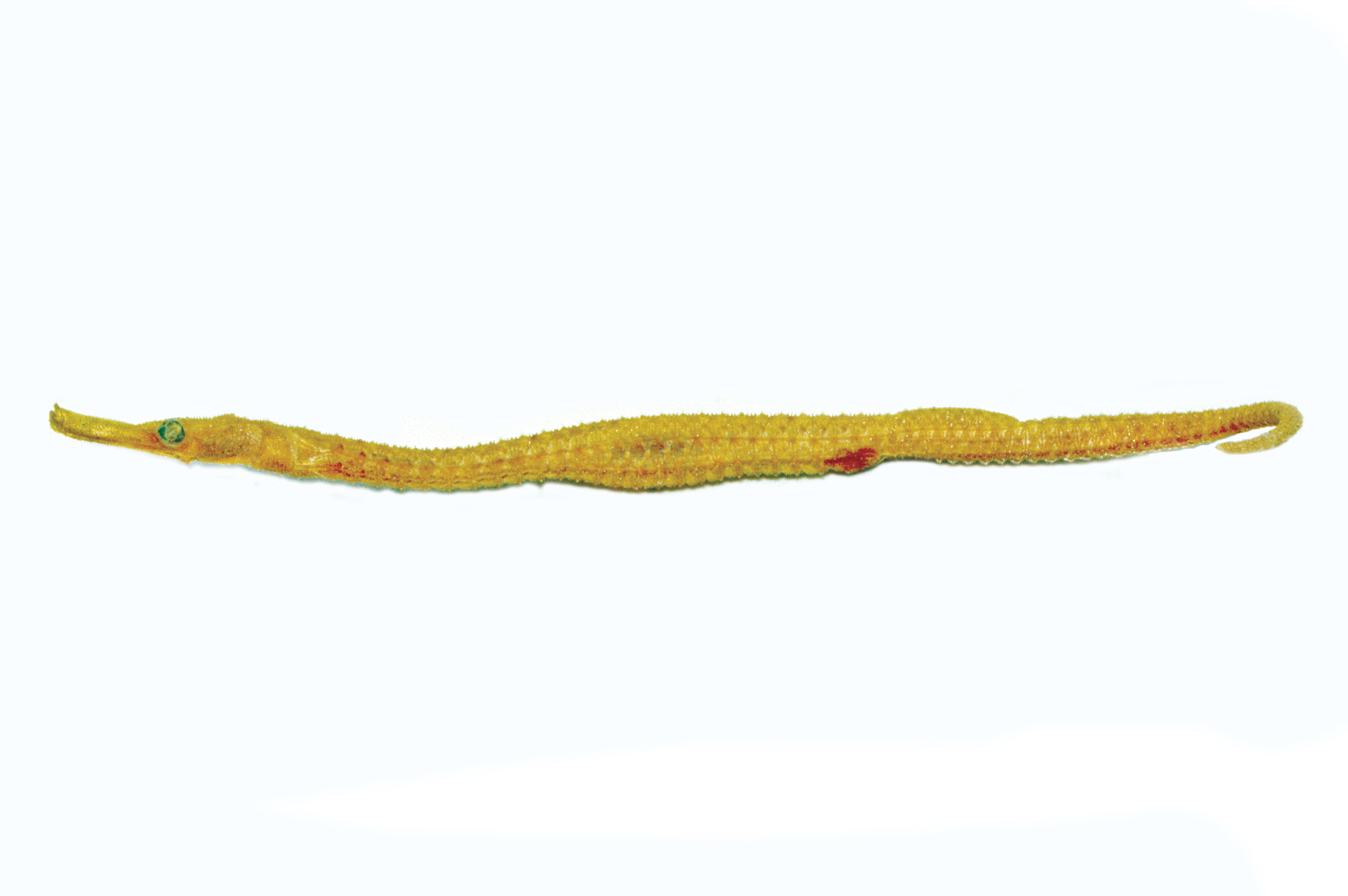Robust Pipehorse, Solegnathus robustus McCulloch 1911

Robust Pipehorse, Solegnathus robustus. Source: Rudie H. Kuiter / Aquatic Photographics. License: All rights reserved
This rare pipehorse is endemic to South Australian waters and nothing is known of its biology.
Robust Pipehorse, Solegnathus robustus McCulloch 1911
More Info
|
Distribution |
Endemic to temperate waters of South Australia, with a limited distribution from Port Weyland, Spencer Gulf westwards to Flinders Island, in 30-68m. Specimens have occasionally been washed ashore after storms. A 2008 report of two specimens of the Spiny Pipehorse taken in giant crab pots in the Victorian Giant Crab fishery in 70-90m cannot have be verified. Although there is no habitat information for this species, pipehorses use their prehensile tails to cling to structures on the seafloor. |
|
Features |
Meristics: D 30-34; P 23-25; trunk rings 25-27; tail rings 47-51; total rings 73-78; total subdorsal rings 8-9.5 Superior trunk and tail ridges discontinuous near rear end of dorsal-fin base; confluent lateral trunk and tail ridges continuous with superior tail ridge. Snout moderately deep, depth less than 5 in snout length; anterior post-dorsal part of tail strongly oval in cross-section; ssupplemental ridges between elevated median ridge on scutella and principal body ridges. Opercular membrane with spinous platelets on sides and ventral surface; body surfaces clearly spinulose; with a short, strong spine under upper 5~8 pectoral-fin rays. Head length about 6.3-7.6 in total length; dorsal surface of trunk and anterior half of tail strongly convex; body surfaces densely spinulose; strong short spine under pectoral fin. |
|
Size |
Maximum length to at least 35 cm. |
|
Colour |
In preservative – pale with no prominent markings. Some specimens with dusky to dark brown shading on lower half of last 2-3 trunk rings. Recently preserved specimens have diffuse dusky shading on side of snout , dorsal surface and upper parts of sides peppered with tiny light brown spots; dorsal surface with minute bilateral spots around the bases of the median marginal spiones on the superior ridges of some rings. |
|
Feeding |
Unknown – pipehorses use their prehensile tails to cling to structures on the seafloor, feeding on drifting crustaceans and other zooplankton. |
|
Fisheries |
Although most specimens have been taken as incidental bycatch in trawls (one specimen was collected in a dredge sample, and others may be collected in cray pots or crab pots), the species is of no interest to fisheries or aquaculture. Several other members of the genus Solegnathus are sold dried in the Traditional Chinese Medicine Industry. |
|
Conservation |
CITES: not listed. IUCN Red List Status: Assessed as Data Deficient on the 2010 IUCN Red List of Endangered Species. Australian Commonwealth legislation: Marine listed under Section 248 of the Environment Protection and Biodiversity Conservation Act 1999 (EPBC Act). Solegnathus robustus is subject to the export controls of the Commonwealth Wildlife Protection (Regulation of Exports and Imports) Act 1982. |
|
Remarks |
A 2008 report of two specimens of the Spiny Pipehorse taken in giant crab pots in the Victorian Giant Crab fishery in 70-90m cannot have be verified. |
|
Similar Species |
Solegnathus robustus is most similar to S. spinosissimus, differing in having a deeper snout (Snout depth 3.7~4.5 in snout length versus 5.6~10.1 in snout length), anterior part of tail strongly oval in cross-section (versus not strongly oval in cross-section), body rings with short ridges between the principal ridges and an elevated median ridge on each scutella (versus the body rings without short longitudinal ridges between the principal ridges and no elevated median ridge on each scutella). The combination of bony platelets on the sides and ventral surface of the opercular membrane, a strong spine under the pectoral fin, ridged scutella, spinulose body surfaces and low numbers of dorsal fin rays (30-34 vs 37-51) distinguishes S. robustus from all other members of the genus Solegnathus except for S. spinosissimus. |
|
Species Citation |
Solegnathus robustus McCulloch 1911, Zool. (Biological) Results. Endeavour 1(1): 28, pl. 9(2), off Flinders Island, SA. |
|
Author |
Dianne J. Bray |
Robust Pipehorse, Solegnathus robustus McCulloch 1911
References
Dawson, C.E. 1982. Synopsis of the Indo-Pacific genus Solegnathus (Pisces: Syngnathidae). Japanese Journal of Ichthyology 29(2): 139-160.
Dawson, C.E. 1985. Indo-Pacific Pipefishes (Red Sea to the Americas). Gulf Coast Research Laboratory, Ocean Springs, Mississippi, USA, 230pp.
Hobday, D., D. Reilly & R. Flint. 2008. Monitoring of byâ€catch and interactions with threatened, endangered and protected species in the Victorian southern rock lobster and giant crab fisheries. Fisheries Victoria Research Report Series No.39: 1-29.
Kuiter, R.H. 2008. Family Syngnathidae (pp. 448–479). In Gomon, M.F., D.J. Bray & R.H. Kuiter. (Eds.) Fishes of Australia's Southern Coast. New Holland Press & Museum Victoria, Melbourne, Australia, 928 pp.
Kuiter, R.H. 2009. Seahorses and their relatives. Aquatic Photographics, Seaford, Australia. Pp. 1–333.
Martin-Smith, K.M. & Vincent, A.C.J. 2006. Exploitation and trade of Australian seahorses and their relatives (syngnathids). Oryx 40(2): 141-151.
Martin-Smith, K.M., Lam, T.F.-N. & Lee, S.K.-H. 2003. Trade in Pipehorses Solegnathus spp. for Traditional Medicine in Hong Kong. Traffic Bulletin 19: 139–148.
McCulloch, A.R. 1911. Report on the fishes obtained by the F.I.S. Endeavour on the coasts of New South Wales, Victoria, South Australia and Tasmania. Part 1. Zoological (Biological) Results. Endeavour : 1–87.
Paxton, J.R., J.E. Gates, D.F. Hoese & D.J. Bray. 2006. Syngnathidae (Pp. 810–846). In Beesley, P.L. & Wells, A. (Eds) Zoological Catalogue of Australia. Volume 35. Fishes. ABRS & CSIRO Publishing, Australia., 3 vols.
Pogonoski, J.J. Pollard, D.A. & Paxton, J.R. 2002. Conservation Overview and Action Plan for Australian Threatened and Potentially Threatened Marine and Estuarine Fishes. Environment Australia, Canberra, 375 pp.
Pogonoski, J., Pollard, D., Paxton, J., Morgan, S. & Bartnik, S. 2008. Solegnathus robustus. In: IUCN 2010. IUCN Red List of Threatened Species. Version 2010.1. <www.iucnredlist.org>. Downloaded on 13 April 2010.
Vincent, A.C.J. 1996. The International Trade in Seahorses. TRAFFIC International, Cambridge, UK.

